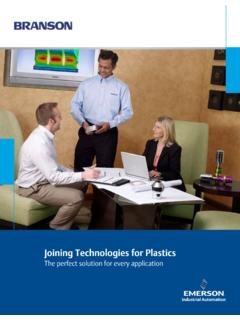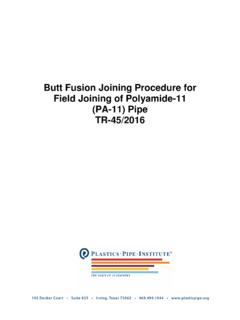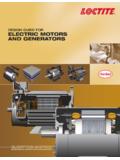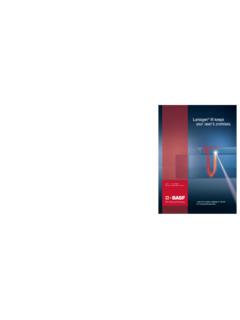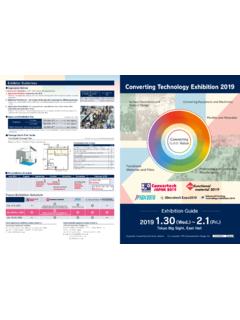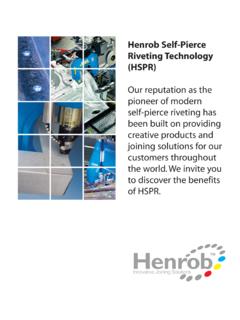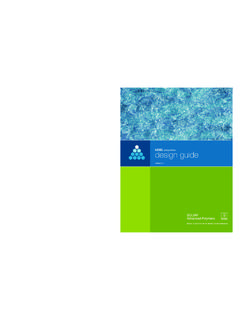Transcription of PULSED LASER WELDING
1 WJM technologies 1 excellence in material joining Girish P. Kelkar, (562) 743-7576 PULSED LASER WELDING Girish Kelkar, , WJM technologies , Cerritos, CA 90703, USA LASER WELDING is finding growing acceptance in field of manufacturing as price of lasers have decreased and capabilities have increased. LASER WELDING is unique since it offers non-contact autogenous WELDING process that is not affected by the electrical conductivity or magnetic properties of the materials being welded. Lasers can be used in PULSED or CW (Continuous Wave) mode.
2 In PULSED mode, LASER welds are similar to resistance spot WELDING and in CW mode they are similar to arc WELDING processes. While CW mode is common for larger structural welds and competes with arc WELDING processes, PULSED WELDING is common for welds in smaller components such as pacemakers, microwave enclosures, batteries, and sensors. Lasers can be used in PULSED mode to make seam welds where overlapping pulses are able to produce a hermetic seal. The LASER pulse has many features that need to be understood to fully appreciate and capitalize on the benefits of LASER WELDING .
3 This paper will discuss all aspects of the LASER pulse including initial coupling, weld fusion, and cooling. Combination of these features can be effectively used to control weld penetration, weld size, WELDING mode (conduction vs. keyhole), residual stress, and related defects such as porosity and cracks. KEYWORDS: PULSED LASER WELDING , coupling, fusion, cooling rate, residual stress, cracks, porosity. INTRODUCTION There are many attributes of LASER light that are uniquely suited for LASER WELDING . A beam of LASER light is monochromatic (single wavelength) and collimated (parallel) and hence can be focused down to a very small spot where the photon density is high enough to melt metals and alloys in a matter of milli-seconds.
4 LASER wavelengths are typically identified by the LASER source used to produce LASER light. The most commonly used for PULSED WELDING is micron Nd:YAG wavelength that has the option of being transmitted through an optical fiber. A new generation of lasers called fiber lasers also have similar wavelength where the LASER light is produced in the fiber itself. Fiber lasers have the benefit of producing good beam quality and hence can have much longer working distance (distance between lens and work piece), of the order of ten inches as compared to about two inches for conventional YAG lasers.
5 Another source commercially available is the micron CO2 LASER , thought that is more often used for continuous wave WELDING rather than for PULSED WELDING . The LASER beam can travel through air or vacuum with minimal loss of energy. In some applications, the entire LASER delivery hardware including focus head and fiber can be mounted inside a glove box where the environment is controlled for oxygen and water vapor contamination as is necessary for WELDING of Titanium. If required, the controlled environment can be produced in a more confined space with the LASER energy being delivered through a quartz window.
6 WJM technologies 2 excellence in material joining Girish P. Kelkar, (562) 743-7576 LASER WELDING does not require that the part being welded be electrically conductive as is required for competing technologies including resistance WELDING , arc WELDING , and electron beam WELDING . Consequently, lasers have been used to weld all types of materials including metals, ceramics/glasses, and plastics. In WELDING of metals, all the LASER energy is absorbed on the surface of the metal where as in glasses, part of the energy is absorbed on the surface while the remaining portion is absorbed in the bulk.
7 WELDING of plastics is performed by facilitating absorption of LASER energy at the weld interface either by using an absorptive layer or having one of the plastic be colored for preferential absorption. Perhaps the most important aspect that has led to the growing use of lasers for WELDING is the ability to make spot welds. A LASER beam focused down to a spot can heat, melt, and solidify metals in a matter of milli-seconds with minimal disturbance to adjoining volume of material and components. Consequently, LASER spot WELDING is finding ever increasing applications in all segments of manufacturing including medical devices, sensors, batteries, and microwave enclosures.
8 Along with growth in applications, there has been substantial improvement in LASER power supply capabilities including closed-loop feedback and pulse shaping. As LASER pulse WELDING is pushed to its limits in new and unique applications, it will be increasingly important to have good understating of the LASER pulse and its effect on the parts being welded. This paper presents insights into the anatomy of a LASER pulse and its effect on weld size, shape, residual stress, and defects. ANATOMY OF A LASER PULSE A LASER pulse can be divided into three different segments: coupling, melting, and cooling.
9 Even though the time frame for each segment is of the order of milli-seconds, and functions of each segment blend into the other, understanding the functionality of the three segments allows the user to carefully tailor the WELDING pulse to produce a desired result. Typical shapes of coupling pulses are shown schematically in Figure 1. COUPLING Metals and alloys are not transparent to LASER light. Photons in the LASER beam that hit a metal surface are either absorbed or reflected. Most metals/alloys are good reflectors of LASER light at room temperature.
10 Figure 2 shows a chart of room temperature absorptivity of typical metals as a function of LASER frequency [1]. Consequently, majority the initial photons that hit the weld area are reflected from the surface. Energy from the select few photons that do get absorbed is converted to heat and raises the local temperature of the metal surface. As temperature increases, so does the absorptivity at the weld surface, and more of the photons that follow are absorbed. Increase in absorptivity with temperature leads to a chain reaction and in a very short time practically all the photons impinging on the weld are absorbed and the weld zone reaches melting point (Figure 3).

